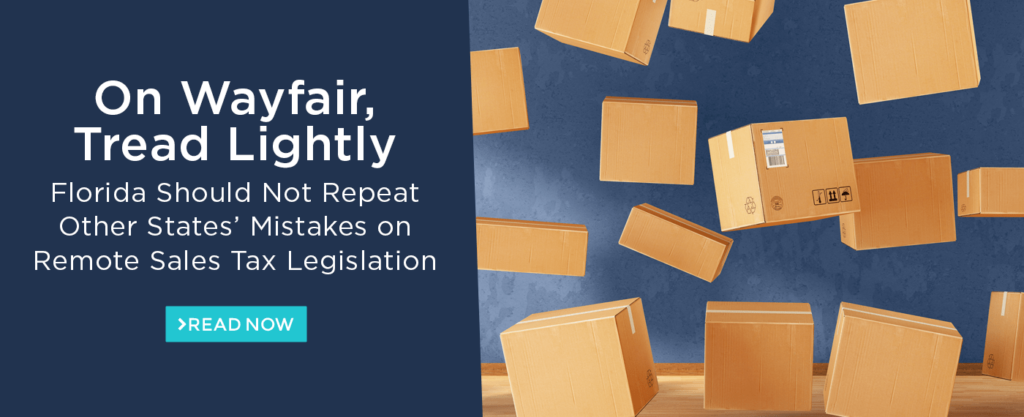Florida Should Not Repeat the Other States’ Mistakes on Remote Sales Tax Legislation
By: Andrew Moylan Executive Vice President, National Taxpayers Union Foundation; Adjunct Scholar, The James Madison Institute
Andrew Wilford Policy Analyst, National Taxpayers Union Foundation; Adjunct Scholar, The James Madison Institute
Click here to read the full PDF of “On Wayfair, Tread Lightly”
Since the release of the Supreme Court’s decision in the 2018 South Dakota v. Wayfair case, states have hurried to implement so-called “economic nexus” rules. This approach allows states to impose tax obligations on any business that sells into the state, even if it is located elsewhere. By now, nearly every state with a statewide sales tax has imposed economic nexus obligations in one shape or another. But with the pandemic putting new emphasis on tax revenues, Florida should proceed with a thoughtful and practical approach that identifies and avoids the mistakes made by other states.
Instead of hastily legislating on this issue to chase a modest revenue bump, Florida legislators should carefully examine the experiences of other states to avoid pitfalls that could result in burdensome rules that impose high compliance costs or, even worse, put the state in danger of litigation.
Background: Wayfair and Economic Nexus
Before the Court presented its decision in Wayfair, a state could only require businesses to collect sales tax on purchases if they had some form of physical presence within that state — be it a retail outlet, a warehouse, or even a sales representative. This “physical nexus” standard applied for decades until 2018, when the Court considered South Dakota v. Wayfair. Ultimately, the majority opinion in the case dispensed with the physical nexus standard in favor of “economic nexus,” which allows states to assert sales tax collection liability on any business making sales into the state, even if no other connection exists.
Advocates of these economic nexus rules claimed that states were missing out on billions of dollars in sales tax revenues from out-of-state retailers. Yet it quickly became apparent that these revenue estimates were overblown.
The National Taxpayers Union Foundation (NTUF) compared estimates made prior to the Wayfair decision of how much revenue economic nexus taxes could raise with post-Wayfair official estimates from 32 states. Prior to Wayfair being argued, the National Conference of State Legislatures had projected that these 32 states would realize around $19 billion in additional revenue from economic nexus rules if the Court were to allow their imposition. Even the more conservative Government Accountability Office estimated states would gain $8.6 billion.
After Wayfair was decided and states began implementing the authority granted them by the Court, the NTUF analysis found that estimated revenue was a fraction of the pre-Wayfair claims by advocates of new tax power. Evaluating official revenue projections found a relatively modest $3.6 billion in added revenue, or an average of just 0.7 percent of these states’ general funds. In other words, despite claims to the contrary, there simply is not a big pot of uncollected revenue that can be accessed simply by passing new remote sales tax rules.
Advocates of economic nexus had missed the mark in large part because of how many out-of-state sales were already taxable. Amazon, the giant of the e-retail space, had already entered into voluntary collection agreements nationwide a year before the Wayfair decision, while many other large e-retail businesses had physical presence through their brick-and-mortar operations, such as Walmart, and thus were already required to collect and remit sales tax on all transactions.












